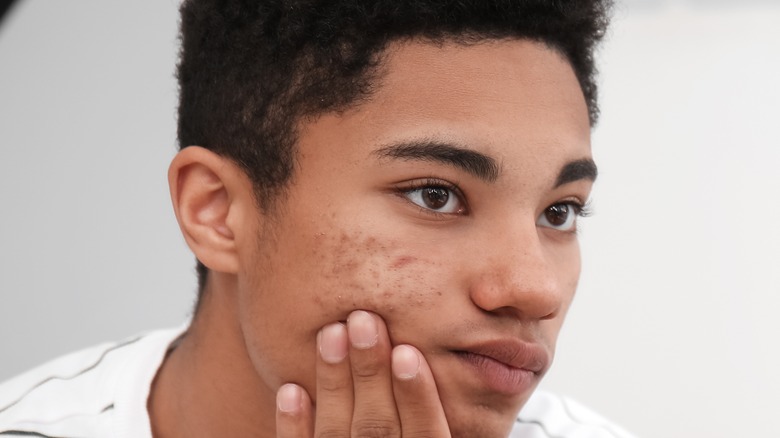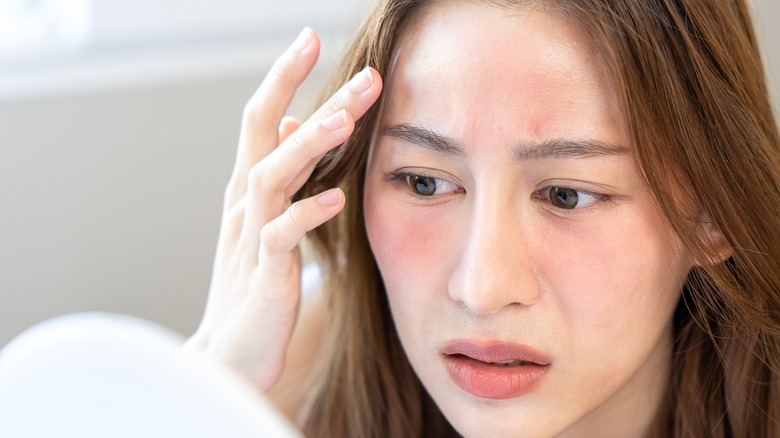What Are Comedolytic Products And How Do They Treat Acne?
Whether you have the occasional blemish or you're prone to acne on a regular basis, comedolytic products may be your answer to saying goodbye to acne. Comedolytic products treat comedones, which you may know as blackheads, whiteheads, or simply acne, according to MedlinePlus. Comedones are flesh-colored bumps that form and give a rough texture to the skin's complexion. When skin cells, oil, and bacteria get trapped in pores, comedones are formed (via Verywell Health). Comedolytic products treat comedones, so if you're in need of a way to treat your acne, look no further.
To understand why comedolytic products are known for getting rid of acne, all you have to do is break down the word's meaning. Per Verywell Health, the word literally means the destruction of blocked pores — "comedo" means breakout or blocked pore, and "lytic" means destruction. That being said, what exactly are comedolytic products and how do they inhibit clogged pores? Here's what you should know about these acne-fighting products.
How comedolytic products work
Simply put, comedolytic products work by opening pores, per Verywell Health. When you use a comedolytic product, your skin sheds more easily and your pores become unclogged. You can think of acne as being brought on by skin cells shedding in abnormal ways, but comedolytic products come to the rescue by correcting this process and helping your skin shed properly. For comedones like blackheads, whiteheads, and pimples, comedolytic products unplug the clogged pores by loosening the blockages so that the oil, bacteria, and skin cells can be pulled from your pores. Comedolytic products can also prevent comedones from forming, therefore keeping your skin clear.
There are several options for comedolytic products, both prescription and over-the-counter (OTC), per Verywell Health. You're probably already familiar with many of the ingredients in comedolytic products, like salicylic acid, benzoyl peroxide, and retinoids. If your acne is mild or you want to prevent future breakouts, OTC solutions, cleansers, creams, and toners including salicylic acid and benzoyl peroxide are likely your best options. Salicylic acid is an effective comedolytic ingredient, and stronger options like salicylic acid peel treatments can be obtained at spas or dermatology offices. Benzoyl peroxide isn't as strong of a comedolytic product, but other ingredients in benzoyl peroxide offerings make it the most successful OTC product in many cases. If your acne is severe, your dermatologist can prescribe comedolytic medications like tretinoin and tazarotene, better known as Retin-A and Tazorac.
Side effects of comedolytic products
Even though comedolytic products are effective at unplugging clogged pores and eliminating breakouts, they do come with potential side effects. Dry skin — skin that is flaky or peels — is the most common side effect that comes with the use of comedolytic products (per Verywell Health). Topical salicylic acid solutions are meant to cause skin to shed, so peeling is not uncommon, reports Everyday Health. You may experience a minor rash or skin irritation, and you might notice the color of your skin change slightly and mimic a whitening effect. With benzoyl peroxide, you may notice redness of the skin and minor stinging or burning with skin irritation, says the National Health Service. If you have any concerns or the side effects become too painful, always consult with your dermatologist or healthcare provider.
According to the Mayo Clinic, there are certain habits you can incorporate into your skincare routine to mitigate the possible side effects of comedolytic products. Be mindful that you aren't using too much of a comedolytic product or using it too often. Moisturizer is critical for treating dry skin, and for best results, look for moisturizers that are water-based and oil-free. Most importantly, don't pick at pimples, try to squeeze them, or attempt to pop them. Keeping your hands away from your face is the best habit you can practice.



